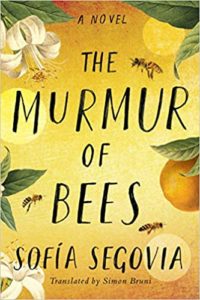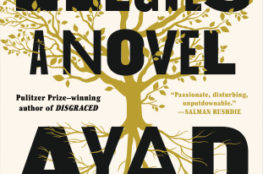Book Review: The Murmur of Bees by Sofia Segovia, translated by Simon Bruni, Amazon Crossing, 2019. Previously published as El murmullo de las abejas by Penguin Random House, 2015.
Although I read all sorts of novels, I am careful when recommending them to my friends. This beautiful novel by Sofia Segovia is one that I have been promoting confidently. It has something for everyone.
The Murmur of Bees is an uplifting story set in northern Mexico during the time of the Spanish flu pandemic and the Mexican Revolution of 1918. It is good reading for 2020, while we are isolated at home and worried that the sky is falling.  The family saga of the Morales clan puts the reader in touch with the struggles of survival, but in this story endurance is not accomplished by the dog eat dog courage of individuals or the ingenuity of a lone problem-solver. It is achieved through the loyalty of family and the supports of a community that stays together through the struggle.
The family saga of the Morales clan puts the reader in touch with the struggles of survival, but in this story endurance is not accomplished by the dog eat dog courage of individuals or the ingenuity of a lone problem-solver. It is achieved through the loyalty of family and the supports of a community that stays together through the struggle.
A murmuration of wild bees is one of the characters in the story. They are not the kind of bees kept in tidy boxes by modern apiarists. The bees of this story are wild bees moving en masse to establish themselves in a spot suited for building their hive. The life of a bee can only be understood in the context of its colony or swarm. An individual bee lives for only forty to sixty days, but the colony itself is a superorganism that can survive indefinitely as it moves about, gathers food, nurtures generation after generation of queens, and shelters in a protected space.
Segovia convinces us that the shared will to survive can accomplish what would at first seem impossible. Written in the style of magical realism that we have come to admire in the literature of her region, the magic of Segovia’s story is down to earth. She warps time and stretches space, but these effects are not so different from the distortions we ourselves create when we attend selectively to what is happening around us and fail to notice what does not fit our expectations. Lived time is fluid, and magical time is flexible. We always live in patterns that are somewhat unpredictable.
The bees of Segovia’s story are an apt device for looking at a world with possibilities beyond what we can see. Bees have five eyes. Two of them have hairs on the surface that allow bees to see the wind. Their sensitivity to ultraviolet light allows them to locate the sun on days when it is hidden behind clouds. They are remarkable navigators. Bees and many other things in nature surround us with a constant murmur of events beyond our ken.

The same skill upon which Segovia draws to show us the magic of nature, is evidenced in the portraits she creates to introduce us to the human actors in her drama. Her characters are both complex and ordinary. She sketches them with earthy honesty. They are types, but they are not stereotypes. The stories within the story are like blocks in a quilt, stitched together firmly along their edges, and formed into a dramatic whole.
Segovia assembles a family portrait in which every sort of love is present. She delicately sketches the love between a traditional father and a free-spirited son, between a woman and her parents, between an aging husband and wife, between the members of a large-hearted family and a foundling they adopt, between a woman who loses her own child and the children for whom she is the wet-nurse. She understands the devotion of a man to the land he has inherited. She introduces us to a boy who cannot speak because of a cleft in his palate and reveals the deep bond he forms with a younger boy whose constant companion and protector he becomes.
This vibrant family, in whose saga we are allowed to share, is no more ideal than any other family. The characters have quirks. They make mistakes, and they seek forgiveness. They are beaten down by tragedy and challenged by the political events taking place around them. Their story weaves through time, and it swerves off in unexpected directions, but it always continues onward. With the voice of Francisco, whom we have followed from birth until he is an old man, Segovia tells us:
“But let me tell you what I know, what I’ve concluded: it doesn’t matter whether time passes slowly or quickly. What you can be sure of is that, in the end, all you want is to have more . . . . More of those annoying arms that picked you up to stop you doing something crazy. More tellings-off from the mother who you thought was a nag. More glimpses, even, of your father hurrying somewhere, always busy. More soft embraces from the wife who loved you all your life, and more trusting looks from your children’s young eyes.”




August 8, 2020
I did not know that bees have five eyes–and that two of those can see the wind. I learned something new, which is one of two reasons I enjoy Mary’s reviews. The other reason is the psychology that informs her reading. Thank you, Mary!